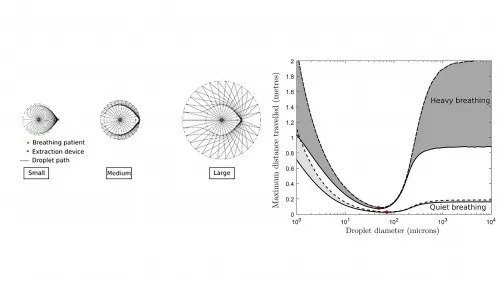Left: Droplet paths from patient to extraction device: small, medium, and large droplets. Right: Maximum horizontal distance covered by exhaled water droplets for various droplet diameters: heavy vs. quiet breathing. The red dot indicates the global minimum in distance covered. In this case, the minimum is attained for droplets of diameters between 50 and 80 microns. Courtesy of Cathal Cummins
The World Health Organization has warned that aerosol transmission of COVID-19 is being underestimated. If aerosol spread is confirmed to be significant, as suspected, we will need to reconsider guidelines on social distancing, ventilation systems and shared spaces. A group of researchers from Heriot-Watt University and the University of Edinburgh in the U.K. believes a better understanding of different droplet behaviors and their different dispersion mechanisms based on droplet size is also needed.
In Physics of Fluids, the group presents a mathematical model that clearly demarcates small-, intermediate- and large-sized droplets. Simple formulas can be used to determine a droplet’s maximum range.
This has important implications for understanding the spread of airborne diseases, such as COVID-19, because their dispersion tests revealed the absence of intermediate-sized droplets, as expected.
“The flow physics of someone coughing is complex, involving turbulent jets and droplet evaporation,” said Cathal Cummins, of Heriot-Watt University. “And the rise of COVID-19 has revealed the gaps in our knowledge of the physics of transmission and mitigation strategies.”
One such gap in the physics is a clear, simple description of where individual droplets go when ejected.
“We wanted to develop a mathematical model of someone breathing that could be explored analytically to examine the dominant physics at play,” Cummins said.
As a person breathes, they emit droplets of various sizes that don’t necessarily follow the airflow faithfully.
“We represent breathing as a point source of both air and droplets and include a point sink to model the effect of extraction of air and droplets,” Cummins said. “To take their size and density differences into account, we use the Maxey-Riley equation, which describes the motion of a small but finite-sized rigid sphere through a fluid.”
This work gives researchers a general framework to understand the droplet dispersion. The model simplicity demonstrates that bimodality could actually be a property of the droplets themselves, and the group provides formulas to predict when such droplets will have short ranges.
“Our study shows there isn’t a linear relation between droplet size and displacement -- with both small and large droplets traveling further than medium-sized ones,” said Felicity Mehendale, co-author and academic surgeon at the University of Edinburgh. “We can’t afford to be complacent about small droplets. PPE is an effective barrier to large droplets but may be less effective for small ones.”
As a solution, Mehendale came up with the idea of creating an aerosol extractor device. The team is working on plans to manufacture the aerosol extractor to keep clinicians safe during a wide range of aerosol-generating procedures routinely performed in medicine and dentistry. Extraction units placed near the droplet sources can effectively trap droplets, if their diameters fall below that of a human hair.
“This has important implications for the COVID-19 pandemic,” said Cummins. “Larger droplets would be easily captured by PPE, such as masks and face shields. But smaller droplets may penetrate some forms of PPE, so an extractor could help reduce the weakness in our current defense against COVID-19 and future pandemics.”
Mehendale said a better understanding of the droplet behavior will help “inform the safety guidelines for aerosol-generating procedures, and it will be relevant during the current and future pandemics, as well as for other infectious diseases. This mathematical model may also serve as the basis of modeling the impact on droplet dispersion of ventilation systems existing within a range of clinical spaces.”
Source: American Institute of Physics (AIP)

Hi to every body, it’s my first pay a visit of this website; this blog consists of awesome and really good stuff in favor of readers.
This is my first time go to see at here and i am in fact impressed to read all at one place.
Howdy I am so grateful I found your webpage, I really found you by mistake, while I was researching on Google for something else, Regardless I am here now and would just like to say cheers for a incredible post and a all round enjoyable blog (I also love the theme/design), I don’t have time to browse it all at the minute but I have book-marked it and also added in your RSS feeds, so when I have time I will be back to read a great deal more, Please do keep up the superb job.
My spouse and I stumbled over here coming from a different web page and thought I might as well check things out. I like what I see so now i am following you. Look forward to looking at your web page again.
you are in point of fact a good webmaster. The site loading speed is incredible. It kind of feels that you are doing any unique trick. Moreover, The contents are masterpiece. you have performed a magnificent activity in this topic!
Fabulous, what a weblog it is! This website provides useful information to us, keep it up.